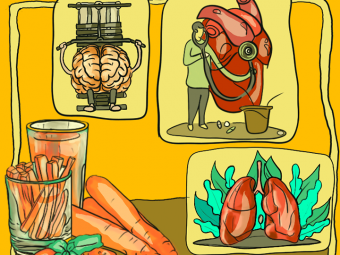Have you observed those green paper wraps on your favorite sushi rolls? These wraps are seaweed, also known as macroalgae. They are edible. The benefits of seaweed are many, and you can find it along the rocky shorelines of the sea. It is highly nutritious and is considered a superfood for its health benefits. Seaweed is also an important food source for marine life and is available in different colors like green, red, and brown. This article explores the nutrition profile of seaweed, types, health benefits, and possible adverse effects. Keep reading to know more.
In This Article
Seaweed Varieties
Seaweed formed an important part of the diet for coastal people in ancient times. Today, more than 145 varieties are used around the world. Most of the edible seaweed varieties differ in color coming from different species. As per their coloring pigment, they are broadly classified as brown algae (Phaeophyceae), red algae (Rhodophyta), and green algae (Chlorophyta).
- Nori, or purple laver, is the common dark-colored seaweed used in sushi preparations. With its high protein and nutrient content, it is one of the most nutritious types of seaweed.
- Aonori, or green laver, commonly known as “sea lettuce” is widely cultivated in Japan.
- Dulse is a type of red algae with leathery fronds.
- Haidai (in China) and Kombu (in Japan) are other types of dried seaweed.
- Other edible seaweed varieties include winged kelp, sea grapes, Irish moss, hiziki, and mozuku.
While seaweeds grow in oceans all over the world, they’re most commonly used in Asian cuisines, in sushi, miso soup, salads, and stews.
Let’s have a look at the nutrition details below.
Seaweed Nutrition Facts
According to the USDA, 2 tablespoons (10g) of seaweed (wakame variety) provides us with the following nutrients (1).
- Calories: 4.5
- Fat: 0g
- Sodium: 87.2mg
- Carbohydrates: 0.9g
- Fiber: 0g
- Sugars: 0g
- Protein: 0.3g
- Magnesium: 10.7mg
- Calcium: 15mg
- Iron: 0.2mg
Seaweed is rich in nutrition and low in calories. It is an important source of nutrients such as iodine, vitamin B12, and vitamin D, iron, calcium, folate, and magnesium.
Going further, let’s explore the many health benefits of seaweed, the superfood.
Health Benefits Of Eating Seaweed
Seaweed contains unique plant compounds that might help prevent a number of diseases and promote good health.
- May Protect Against Asthma
Since asthma is an inflammatory disease closely related to diet and environmental factors, the dietary intake of omega-3 fatty acids and vitamins found in seaweed seems to help in lowering the development of asthma. Higher intakes of seaweed and seafood have been associated with lower risks of asthma. Research on similar lines found a 34% reduction in the prevalence of doctor-diagnosed asthma on the dietary intake of seaweeds. Though more research is warranted, introducing seaweed early in pregnancy and childhood appears to be beneficial in preventing asthma (2).
- May Reduce Risk Of Osteoporosis
Seaweed contains antioxidant compounds called fucoidans which are indicative of protecting the bone-building cells, osteoblasts (3). This may help prevent bone damage and osteoporosis. A seaweed diet is also enriched with calcium and vitamin K, two key nutrients for bone strength (4).
- May Promote Heart Health
Inflammation, high cholesterol, oxidative stress, and high blood pressure are all potential symptoms of cardiovascular health concerns. Seaweed is rich in soluble fiber, antioxidants, and vital minerals that help alleviate these concerns and improve your heart health (5). Soluble fiber is known to bind to and help remove bad cholesterol from the body (6). Seaweed, especially kombu and dulse, are rich sources of soluble fiber (7), (8). In one study, rats with high cholesterol were given a high-fat diet supplemented with 10% freeze-dried seaweed. The results showed 40% lower total cholesterol, 36% lower LDL cholesterol, and 31% lower triglyceride levels (9). Additionally, the potassium in seaweed can also help lower blood pressure (5).
- May Help Proper Thyroid Functioning
Seaweed is rich in iodine that supports the proper functioning of the thyroid gland. The thyroid gland relies on iodine to make hormones. Seaweed can absorb highly concentrated amounts of iodine from the ocean water (10).
Without enough iodine, your body suffers from a condition called hypothyroidism with symptoms like fatigue, sudden weight changes, and swelling of the neck over time (11). The recommended dietary intake (RDI) for iodine is 150 mcg per day (12). Just one teaspoon (3.5 grams) of dried kelp could contain 59 times the RDI (13).
The average iodine content of three other dried seaweed varieties is as below (13):
- Nori: 37 mcg per gram (25% of the RDI)
- Wakame: 139 mcg per gram (93% of the RDI)
- Kombu: 2523 mcg per gram (1,682% of the RDI)
Along with iodine, the amino acid called tyrosine found in seaweeds also helps the thyroid gland function properly (14).
- Rich In Antioxidants
In addition to containing the antioxidant vitamins A, C, and E, seaweed contains a wide variety of beneficial plant compounds like carotenoids and flavonoids. These are known to protect our body from the effects of toxic free radicals (15), (16).
Fucoxanthin, the main carotenoid found in brown algae such as wakame, has 13.5 times the antioxidant capacity of vitamin E (15). It has been shown to protect cell membranes better than vitamin A (17). Seaweed is rich in a few other plant compounds with antioxidative properties as well (18).
- May Help Improve Blood Sugar Levels
As per a study conducted on Japanese people, fucoxanthin, a carotenoid found in brown seaweed, might help improve blood sugar control (19). Participants were given a local seaweed oil containing either 0 mg, 1 mg, or 2 mg of fucoxanthin. Those who received 2 mg of fucoxanthin were reported to have improved blood sugar levels, compared to the group who had received 0 mg (19). The study also noted additional improvements in blood sugar levels in those who are genetically predisposed to insulin resistance usually associated with type-2 diabetes.
Additionally, the fiber alginate in seaweeds was found instrumental in preventing spikes of blood sugar levels in animals after being fed a high-sugar meal. Studies suggest that alginate may help reduce the absorption of sugar into the bloodstream (20), (21).
- Seaweed Might Help In Weight Loss
Seaweed varieties contain a good amount of fiber that helps you feel full and delay your hunger pangs, thereby making you eat less (22). A 5g serving of brown, red, or green seaweed has been found to contribute up to 14.28%, 10.64%, or 12.10% of dietary fiber intake, respectively (23). Seaweed is also known to have anti-obesity effects. As per a few animal studies, compounds like alginate and fucoxanthin found in seaweed might also have fat-reducing effects (24), (25). Although these studies’ results seem promising, further research on humans is warranted to establish the findings.
Going further, let’s see how you can include seaweed in your diet to reap its many benefits.
How To Include Seaweed In Your Diet
Seaweed can be used fresh or as dried flakes. Let’s explore the different ways you can add seaweed into your diet:
- Make onigiri from rice and dried seaweed nori wrappers.
- Add it to your soups and salads.
- Add kombu to cooked beans.
- Make different varieties of homemade sushi.
- Mix fresh arame and wakame with vinegar, sesame oil, scallions, and garlic for a seaweed salad.
- Make a vegan salad with chickpeas, vegan mayonnaise, celery, red onion, salt, pepper, and dulse flakes.
- Top meals with a mix of ground nori, kombu, dulse, salt, black pepper, and sesame seeds.
- Make a soup broth with dried kelp or kombu.
Subscribe
Having said that, do you know when and how you can source seaweed? Let’s explore that in the next section.
Best Time To Consume Seaweed
Seaweeds meant for human consumption were usually collected fresh from the seashore or picked in the sea. They were harvested locally and eaten fresh within a short span of time.
Soon people realized that seaweeds can be dried, transported easily, and stored for a longer time in dried form. This makes them readily available all through the year. So in case, you can’t get fresh seaweed in your region, you can most likely get your hands on some variety of dried seaweed in a nearby Asian grocery store. Seaweed farming or cultivation is also being widely practiced all over the world to meet its rising demand and popularity.
Having said that, let’s have a look at some of the potential drawbacks of seaweed.
Side Effects And Drawbacks Of Seaweed
Eating fresh seaweed as such is considered safe for most people. While the plant offers many health benefits as seen above, there are a few things to keep in mind before having seaweed.
Seaweed is a natural source of vitamin K, which might interfere with the anticoagulant effects of blood-thinning medicines like Coumadin (warfarin) (26). If you take seaweed or foods high in vitamin K regularly you should inform your doctor to help determine the right dosage of such medication (27).
Depending on the source of seaweed, it might contain high levels of heavy metals like mercury, lead, cadmium, and arsenic. Alternating between the types of seaweed and limiting your intake frequency might help you reduce heavy metal exposure from seaweed (28).
Seaweed may also be high in sodium unless it is organic.
Now let’s look into how you should store seaweed and the safety precautions you can take.
Storage And Food Safety
- Fresh seaweed like other leafy greens should be washed and cleaned under running water before consumption or further preparation. It can then be used directly or stored in the fridge for later use.
- Packaged dried seaweed, once opened, should be kept sealed or stored in an airtight container. Look for the “use by” date mentioned on the package and preferably get branded products to avoid any heavy metal toxicity.
The benefits of seaweed are varied and plentiful. It is a popular Asian ingredient, frequently featured in sushis, salads, and soups, among many culinary preparations. Seaweed is loaded with beneficial compounds, vitamins, and minerals that promote overall health. It may help promote heart and bone health. Seaweed is good for thyroid functioning as it contains a good amount of iodine. It may help manage diabetes and weight loss as well. However, excessive consumption may interfere with blood-thinning medications or lead to heavy metal poisoning. Hence, limit its consumption and seek medical advice if you experience any side effects.
Frequently Asked Questions
Is seaweed healthy to eat every day?
Yes. Fresh and dried seaweeds have a good nutritional profile and may help boost your health in many ways. However, moderation is key.
Does seaweed have collagen?
No. Polysaccharides from seaweed, however, inhibit collagenase, a substance that degrades skin collagen and causes skin sagging (30).
Key Takeaways
- Seaweed or macroalgae is an edible marine alga with a rich nutritional profile.
- The presence of unique plant compounds in seaweed may help prevent diseases like asthma, reduce the risk of osteoporosis, and promote heart health.
- However, the high vitamin K levels in seaweed may interact with blood-thinning medications like warfarin.
Sources
Articles on StyleCraze are backed by verified information from peer-reviewed and academic research papers, reputed organizations, research institutions, and medical associations to ensure accuracy and relevance. Read our editorial policy to learn more.
- ‘Seaweed’ ‘wakame’ raw
https://fdc.nal.usda.gov/fdc-app.html#/food-details/170496/nutrients - Asthma and Dietary Intake of ‘Fish’ ‘Seaweeds’ and Fatty Acids in Korean Adults
https://www.mdpi.com/2072-6643/11/9/2187 - Antioxidant Fucoidans Obtained from Tropical Seaweed Protect Pre-Osteoblastic Cells from Hydrogen Peroxide-Induced Damage
https://www.mdpi.com/1660-3397/17/9/506 - The Effects of Marine Algae on Osteoporosis
https://www.researchgate.net/publication/335840995_The_Effects_of_Marine_Algae_on_Osteoporosis - Seaweeds as Preventive Agents for Cardiovascular Diseases: From Nutrients to Functional Foods
https://www.researchgate.net/publication/283790681_Seaweeds_as_Preventive_Agents_for_Cardiovascular_Diseases_From_Nutrients_to_Functional_Foods - Fiber and cardiovascular disease risk: how strong is the evidence?
https://pubmed.ncbi.nlm.nih.gov/16407729/ - ‘EDEN’ KOMBU SEA VEGETABLE
https://fdc.nal.usda.gov/fdc-app.html#/food-details/1469507/nutrients - DULSE
https://fdc.nal.usda.gov/fdc-app.html#/food-details/1589432/nutrients - Antioxidant and hypolipidaemic properties of red seaweed
Gracilaria changii - Assessment of Japanese iodine intake based on seaweed consumption in Japan: A literature-based analysis
https://www.ncbi.nlm.nih.gov/labs/pmc/articles/PMC3204293/ - Hypothyroidism – new aspects of an old disease
https://www.ncbi.nlm.nih.gov/pmc/articles/PMC2895281/ - RDA and AIs.Vitamin and Elements.doc
https://www.nal.usda.gov/sites/default/files/fnic_uploads/RDA_AI_vitamins_elements.pdf - Analysis of iodine content in seaweed by GC-ECD and estimation of iodine intake
https://www.sciencedirect.com/science/article/pii/S1021949814000155#bib32 - Health Consequences of Iodine Deficiency
https://www.ncbi.nlm.nih.gov/labs/pmc/articles/PMC3074887/ - Biosynthetic Pathway and Health Benefits of Fucoxanthin
an Algae-Specific Xanthophyll in Brown Seaweeds - Antioxidant and cytotoxic activities of three species of tropical seaweeds
https://www.ncbi.nlm.nih.gov/pmc/articles/PMC4587585/ - QUENCHING MECHANISMS AND KINETICS OF CAROTENOIDS IN RIBOFLAVIN PHOTOSENSITIZED SINGLET OXYGEN OXIDATION OF VITAMIN D2
https://onlinelibrary.wiley.com/doi/abs/10.1111/j.1745-4514.2000.tb00717.x - Seaweed extracts and unsaturated fatty acid constituents from the green alga Ulva lactuca as activators of the cytoprotective Nrf2–ARE pathway
https://www.ncbi.nlm.nih.gov/pmc/articles/PMC3663146/ - Reduction of HbA1c levels by fucoxanthin-enriched akamoku oil possibly involves the thrifty allele of uncoupling protein 1 (UCP1): a randomised controlled trial in normal-weight and obese Japanese adults
https://www.ncbi.nlm.nih.gov/pmc/articles/PMC5465861/ - Non-starch polysaccharides extracted from seaweed can modulate intestinal absorption of glucose and insulin response in the pig
https://www.ncbi.nlm.nih.gov/pubmed/10737549/ - Effects of soluble sodium alginate on cholesterol excretion and glucose tolerance in rats
https://www.ncbi.nlm.nih.gov/pubmed/8941868/ - Emergent Sources of Prebiotics: Seaweeds and Microalgae
https://www.ncbi.nlm.nih.gov/labs/pmc/articles/PMC4771980/ - Risks and benefits of consuming edible seaweeds
https://academic.oup.com/nutritionreviews/article/77/5/307/5370317 - Laminaria japonica as a food for the prevention of obesity and diabetes
https://www.ncbi.nlm.nih.gov/pubmed/22054948 - ‘Fucoxanthin from edible seaweed’ ‘Undaria pinnatifida’ shows antiobesity effect through UCP1 expression in white adipose tissues
https://pubmed.ncbi.nlm.nih.gov/15896707/ - ‘Seaweed’ ‘vitamin K’ and warfarin
https://pubmed.ncbi.nlm.nih.gov/11763808/ - Hyperkalemia
https://www.ncbi.nlm.nih.gov/books/NBK470284/ - Metals in edible seaweed
https://www.researchgate.net/publication/312347377_Metals_in_edible_seaweed - Potential Use of Seaweed Bioactive Compounds in Skincare—A Review
https://www.researchgate.net/publication/337806584_Potential_Use_of_Seaweed_Bioactive_Compounds_in_Skincare-A_Review - Potential Use of Seaweed Bioactive Compounds in Skincare—A Review
https://www.ncbi.nlm.nih.gov/pmc/articles/PMC6950024/
Related
The following two tabs change content below.
- Author
- Reviewer

Varsha Patnaik
Varsha holds a master’s degree in biotechnology from Ravenshaw University, Cuttack, and is a certified diet and nutrition coach. She… more
Kate Driver
(ND )Kate Driver is a Naturopath, Women’s Health Coach, and Perimenopause Practitioner and has been consulting for over 22 years. She… more



 29 Amazing Benefits Of Figs For Skin, Hair And Health
29 Amazing Benefits Of Figs For Skin, Hair And Health 19 Amazing Benefits Of Black Chickpeas (Kala Chana) For Skin, Hair And Health
19 Amazing Benefits Of Black Chickpeas (Kala Chana) For Skin, Hair And Health 28 Best Shea Butter Benefits For Skin, Hair And Health
28 Best Shea Butter Benefits For Skin, Hair And Health 15 Best Benefits Of Beta Carotene For Skin, Hair And Health
15 Best Benefits Of Beta Carotene For Skin, Hair And Health 29 Amazing Benefits Of Sesame Seeds For Skin And Health
29 Amazing Benefits Of Sesame Seeds For Skin And Health 4 Reasons Goat Cheese Is Better Than Cow Cheese
4 Reasons Goat Cheese Is Better Than Cow Cheese 38 Benefits Of Lime For Skin, Hair, And Health + Nutrition
38 Benefits Of Lime For Skin, Hair, And Health + Nutrition Rice Water For Skin – How To Use It For Maximum Benefits
Rice Water For Skin – How To Use It For Maximum Benefits 9 Benefits Of Cranberry Tea For Health And Recipes To Try
9 Benefits Of Cranberry Tea For Health And Recipes To Try